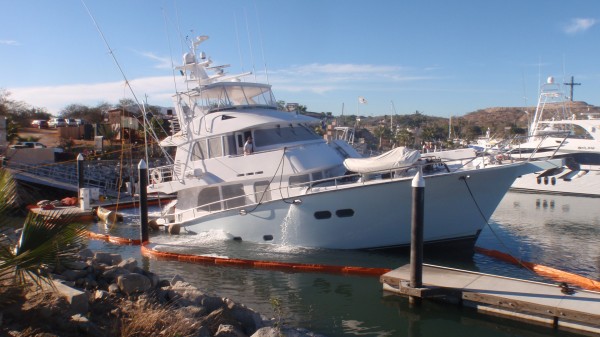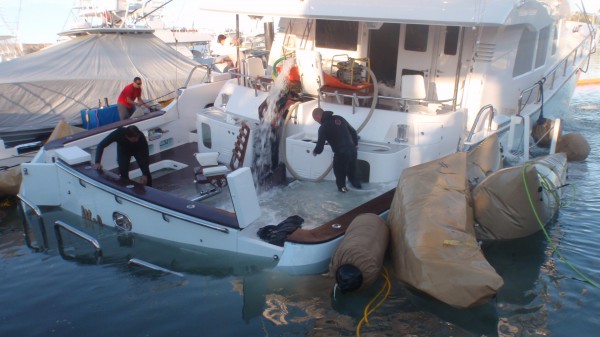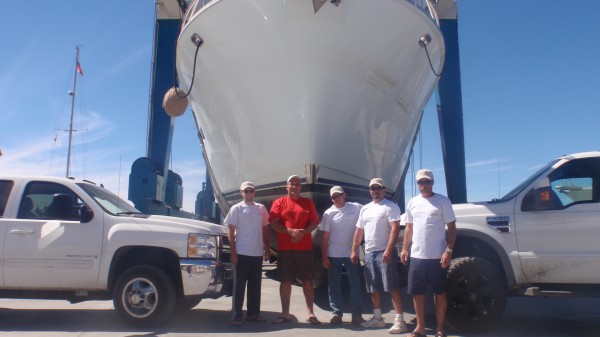VTowBoatUS San Diego’s Crew makes journey to San Jose Del Cabo to salvage a 150 ton Yacht sunk in her slip

Often times when the call comes in to raise a boat after it sinks in its slip, two things are pretty common. One, Vessel Assist San Diego’s crew are usually on scene and working within an hour or two of mobilizing. Two, the boat is usually less than 40 feet long. Both of these scenarios were thrown out the window on a five day journey to the tip of Baja Mexico. The toughest part of conducting long range salvage is making sure you take the most effective equipment with you to get the job done. The yacht was a 75 foot Nordhaven sunk and sitting upright in her slip. When Yachts of this magnitude sink, the pressure is on to get the boat out of the water, and render repairs as soon as possible. The call came in around 11 a.m. and Vessel Assist was contracted around 2pm. The five man crew with two trucks loaded to the hilt crossed the border at 8 pm. Crossing the Tijuana boarder with declarable goods is quite the process. The key is to not play games, go directly to the declaration staging area and get started with paperwork. Often, people attempt to sneak by hoping for a green light. If they pass they are on their way. If they get the red light, it turns into a process that starts with you empting everything out of your truck or car declaring it then loading it back into your truck. We took the high road and declared and after about 30 minutes which included a visit to the immigration office to get our Visas we were under way, paying a modest $250.00us import tax. Now the daunting task of driving through Tijuana and Ensenada at night became our focus. Driving a 3500 diesel Chevy dually, Captain Robert Butler and his brother Salvage specialist Tom Butler took the lead. Captain Shane Thompson, Captain Greg Rood and Salvage Diver Augustine Malfavon followed in Roberts daughters F-250 diesel designed for beach salvage work. Since Otay is the easiest way to cross the border the journey started taking the back road towards Rosarita and the highway toll road. By taking the back way several minutes and one toll stop was saved. The boarder city drive on through Ensenada was un-eventful. Captain Robert Butler has made the trek up and down the Baja dozens of times for both work and play so all the shortcuts were utilized to get the crew south of Ensenada and headed toward San Quintin. Driving in Mexico requires stopping at the military check points. Everyone must get out of their vehicles during a short but thorough search for guns and drugs. The roads from Ensenada to San Quintin are some of the most treacherous roads of the Baja. The two lane road is very busy as the only way to get from one city to another. Cars driving 70 and cars driving 10 miles per hour can be encountered at almost every turn. The Local trucking traffic is also very heavy as San Quintin is a big agriculture exporter. About 45 miles south of San Quintin there is a little town called El Rosario. This town is just after a very steep and winding road. Only about 1 mile long, the first thing you will see is a Pemex station. This is important as you must stop here for fuel especially if you’re towing a load. The roads through the mountains are much improved with extensions on the shoulders of the curvy road and lots of reflectors on the road. Yet there is no room for error, although not as busy as the northern part of the highway, one wrong move or mishap and it is guaranteed your day will be ruined. 220 miles south of El Rosario the salvage team crossed over the State line dividing North Baja and South Baja. After driving all night the crew stopped for a quick bite to eat at El Burro beach south of Mulege. The southern part of the drive like the entire trip went smooth as one could expect. After Lapaz, there is a highway that runs into Totos Santos making the run to Cabo a fast one in terms of driving in Mexico. The wary Crew rolled into San Jose Del Cabo around 8 pm Cabo time or 23 hours after they crossed the border. A quick meeting and a look at the boat and the crew headed off to their hotel for some well-deserved rest. The morning came early as the task at hand was a big one. As the Vessel Assist crew mobilized for the salvage operation a new twist was entered into the scenario. Five dolphins were just introduced into their new swimming pen just a few hundred feet from the sunken vessel. The dive duo, Captain Shane Thompson and Augustine Malfavon focused of keeping any fuel inside the boat. There was a reported 3000 gallons of fuel in the boat and because the boat was in the upright position it only took a little plugging of vents and some extra Haz mat preparedness to insure the fuel would not escape into the water. Seven trash pumps were places in hatches pumping full speed at the rate of 90,000 gallons per hour. 60,000 lbs. of float bags were attached to the stern of the Vessel for additional lift. Lines had to be attached to the highest part of the yacht and attached to anchor points to prevent the huge yacht from rolling over. Ten hours of hard work and the once pristine yacht was floating. A failed bait pump was the cause of the 75’ yacht’s sinking.
Captain Robert Butler used a couple super Pongas to slowly tow the water logged yacht to the boat yard. The final obstacle was the travel lift had a maximum lift of 150 tons and the 75’ monster weighed 150 tons before it became water logged. After several hours of pumping the smallest of compartments the yacht was slowly lifted from the water and maneuvered into the yard to begin the seemingly endless job of stripping the boat for preparation to be rebuilt. The tired crew spent a day in the warm Southern Baja Sun with a little R&R before they made the dangerous drive back to San Diego.



